Dairy Farmer-led Group: climate change evidence
A summary of existing evidence around the dairy sector, including greenhouse gas emissions produced by Rural and Environment Science and Analytical Services (RESAS) division.
2 Greenhouse Gas Emissions and Biodiversity
2.1 Sector Emissions
The Scottish Government has committed to reaching net zero emissions by 2045, including a reduction, from 1990 levels, of 75% by 2030. Whilst a number of countries have adopted net zero targets by on or around 2045, Scotland's 2030 target is particularly ambitious and requires quick action.
Scotland has a legal requirement to meet these goals, and every industry must adjust to contribute to reducing emissions. The Greenhouse Gas (GHG) inventory measures the domestic emissions, i.e. those produced in Scotland. It is the key data source against which Scottish Government measures its progress against its net zero targets. Emissions arising from goods produced in Scotland and exported overseas for consumption are counted in the Scottish GHG inventory. Emissions arising from goods produced overseas and imported into Scotland for consumption are not counted in the Scottish GHG inventory.
In 2018 total Scottish emissions were 41.6 million tonnes of carbon dioxide equivalent (MtCO2e). The 2019 figures are scheduled to be published in summer 2021.
In 2018 emissions from agriculture were 7.5 MtCO2e, or 18% of Scottish emissions. The sectoral envelope for agriculture as set out in the Climate Change Plan update requires a reduction, from current levels, of agricultural emissions of 2.4 MtCO2e to 5.3 MtCO2e[8] by 2032, the equivalent of a 31% reduction from 2018 levels. As shown in the chart below this requires agriculture to reduce emissions at a pace nearly four times faster than historic reductions. Progress towards delivering the plan will be part of statutory annual reporting at a sector by sector level, to the Scottish Parliament from May 2021 onwards.
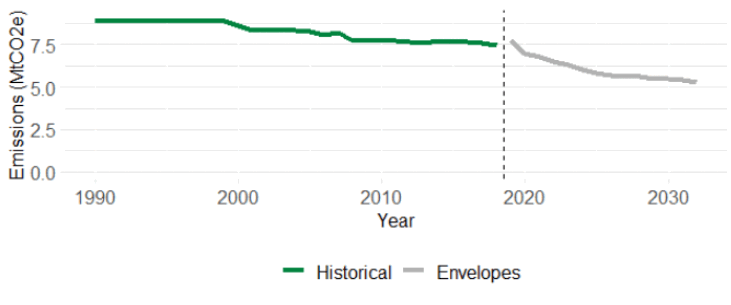
Source: Scottish Greenhouse Gas Emissions 2018 - gov.scot (www.gov.scot), Securing a green recovery on a path to net zero: climate change plan 2018–2032 - update - gov.scot (www.gov.scot)
Note: there is a small break in the series due to a slight mismatch in the historic data and the forecast envelopes
2.1.1 Emissions from Dairy farms
As shown in the chart below dairy cattle contributed 1.17 MtCO2e in 2018, or 16% of agricultural emissions. This is a 0.12 MtCO2e fall since 1990, or 9% driven by a decline in dairy cattle numbers. These figures relate to the 176,000 female dairy cows aged two years plus with offspring. However, a further 0.25 – 0.37 MtCO2 of emissions are likely associated with the 89,000 other dairy cows and 56,000 dairy calves aged one year and under in section one. This level of detail on the inventory methodology is not yet available.
Milk output in Scotland has remained broadly steady with little change in the last 10 years. Between 1990 and 2018, there was an increase of around 6%. (Milk Production Survey, published in ERSA 2020 and 1991). Since cattle numbers have fallen, this suggests a significant increase in efficiency. Increased emissions efficiency support reduction of overall emissions, but only as long as the total level of production remains stable or decreases.
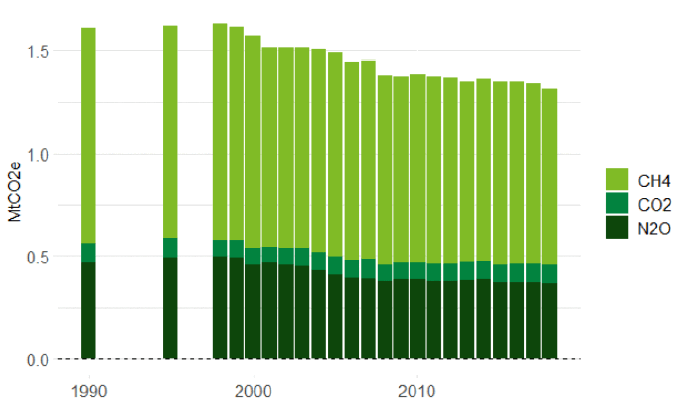
Source: Scottish Greenhouse Gas Emissions 2018 - gov.scot (www.gov.scot)
Of the 1.17 MtCO2e in 2018, 0.86 MtCO2e are directly attributable to dairy cattle in the inventory. This suggests annual emissions per dairy cow in the region of 4,900 kgCO2e per year – substantially higher on a per cow basis than cattle raised for beef which is in the region of 2,600 kgCO2e per year. The inventory estimates direct emissions from the dairy herd, which do not reflect the dual purpose nature of dairy cows as they provide both milk and beef, with the largest part of their output being milk. Therefore, emissions per kilogramme of protein are lower for the dairy herd than for the suckler beef herd.[9]
According to analysis carried out by SRUC and ClimateXChange on Scottish data, beef from the dairy herd has an emissions intensity less than half of beef from the suckler herd (9.2 kgCO2e/kg and 21.2 kgCO2e/kg carcass weight, respectively). This is because most of the emissions from dairy systems are allocated to milk. Comparatively, milk has very low emissions intensity, at 1.2 kgCO2e/kg of milk.
The remaining 0.31 MtCO2e are sources such as crop residues, liming and inorganic fertilisers. These are covered in aggregate in the inventory and not listed specifically by sector. Based on discussions with experts we have attributed these as shown in Annex B.
2.1.2 Sources
The chart below shows how the 2018 emissions from dairy break down by source and pollutant. Enteric fermentation is the largest source contributing 45% of dairy emissions. The next largest source, contributing a further 14%, is manure management.
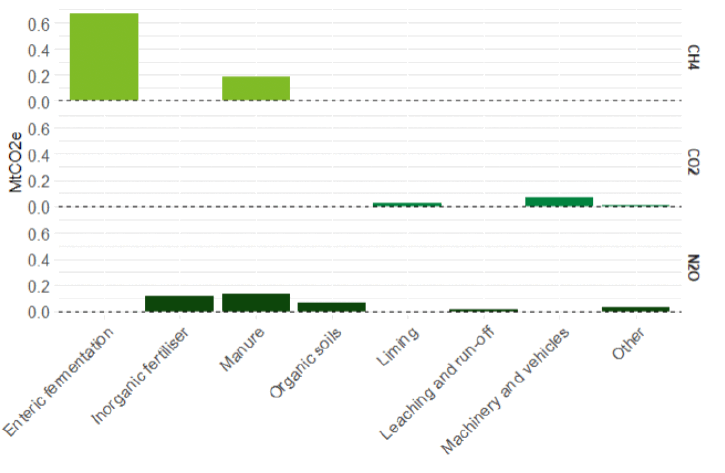
Source: Scottish Greenhouse Gas Emissions 2018 - gov.scot (www.gov.scot)
Alternatively, this can be viewed as a pie chart. Due to multiple sources, the smallest sources (urea application, managed manure, atmospheric deposition, nitrogen leaching, and urine and dung from grazing ) have been grouped under "Other".
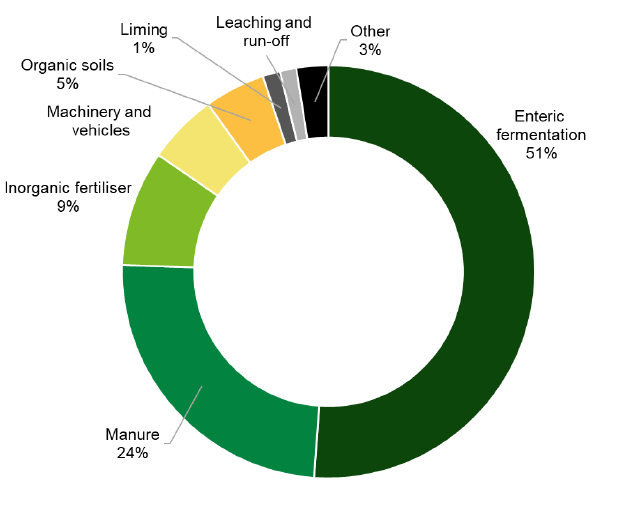
Source: Scottish Greenhouse Gas Emissions 2018 - gov.scot (www.gov.scot)
Over time, the largest reduction by source has come from a reduction in total emissions from non-organic fertilisers. Most other sources have shown only small change since 1990, though in some cases, such as manure management, there has been an increase. The increase in emissions from manure management is offset by the decrease in emissions from non-organic fertilisers.
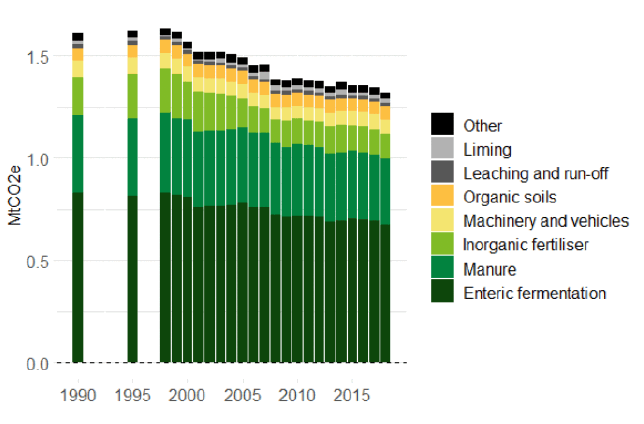
Source: Scottish Greenhouse Gas Emissions 2018 - gov.scot (www.gov.scot)
2.2 Options for Reducing Emissions
2.2.1 Potential Savings
Research undertaken by CXC and SRUC on behalf of Scottish Government assessed the potential savings from a range of mitigation measures that could be applied in Scotland and the likely maximum uptake that could be achieved. The report did not assess timescales for uptake of these measures, which will be influenced heavily by factors such as behaviour change and policies. Table 8 below summarises the measures that could be applied in the dairy sector. Estimates of the aggregate emissions savings have been added based on most recent data on levels of dairy cattle. There will be some overlap with potential reductions in beef emissions with the SBCS.
| Mitigation measure | Dairy Cattle 2020 | Maximum Uptake 2050 | Per unit mitigation (kg CO2e) |
Aggregate Mitigation (MtCO2e) |
|---|---|---|---|---|
| 3NOP feed additive | 321,000 | 53% | 860 | 0.15 |
| Breeding low methane cattle | 19% | 630 | 0.04 | |
| Slurry cover - impermanent | 31% | 530 | 0.05 | |
| Improved health | 75% | 60 | 0.01 | |
| High starch diet | 5% | 160 | 0.003 | |
| Precision diet | 26% | 100 | 0.009 | |
| Additive Total | 0.27 |
Source: Marginal abatement cost curve for Scottish agriculture (climatexchange.org.uk)
Strictly speaking the 'additive totals' overstate the savings as some measures may interact and reduce the impact of other measures. However these interactions were assessed to be relatively low for dairy and these interactions could mainly happen between 3NOP feed additive for dairy and dairy breeding for low methane emissions.
If each of these measures were applied to their maximum potential as identified in the report, estimated reductions from dairy emissions based on current levels of dairy cattle would be in the region of 0.27 MtCO2e.
This would be around a 22% reduction in terms of 2018 emissions from the dairy sector it would still only be 11% of the 2.4 MtCO2e reductions required by agriculture by 2032 with the remaining 89% needed to come from elsewhere in the sector. A reduction of 2.4 MtCO2e is equivalent to a 31% reduction from 2018 levels. Therefore, even if all agricultural sectors were to achieve an equivalent 22% reduction in their emissions this would not be sufficient, by nearly a third, for the agriculture sector to meet its envelope by 2032.
The Climate Change Committee states changes in farming practices, woodland planting and reductions in livestock numbers are all required to achieve net zero. Their advice also highlights three key changes required to reduce agricultural emissions:
1 - Diet change with their main pathway to net-zero assuming a 20% reduction in UK consumption of red meat by 2030, rising to 35% by 2050
2 – Low-carbon farming practices, similar to those outlined above
3 – Productivity measures to improve crop yields and reduce stocking rates
It is important to note that the figures above are average estimates that were provided for Scotland as a whole and may not reflect issues specific to dairy cattle. Further, on an individual farm basis, both the mitigation and the net costs (below) can be very different and some measures above cover a wide range of possible actions which would be demanding to assess individually. Therefore the GHG benefits achieved and costs could vary widely.
Further details on each of these measures, such as costs, underpinning assumptions, constraints and potential uptake can be found on pages 12-13 of the CXC report and in the Annexes on pages 43-53. They have also been collated into Annex C for ease.
Other sources of evidence on mitigation measures are available, including reports by the WWF, CCC, and Defra. These are based on (or heavily influenced by) the work carried out by the same team at SRUC as the measures included here.
As set out within the CXC report, there is scope for Scottish dairy farmers – as with all sectors in agriculture – to mitigate their operational GHG emissions through other practises and alternative land use such as those to encourage carbon sequestration.
2.2.2 Costs
Some of these measures would involve the purchase of capital equipment with upfront costs. The table below shows the net costs to farmers including capital costs on an average annual basis. These do not include any wider costs such as those to Government or Research and Development from developing measures. Negative figures above indicate a net saving to the farmer, i.e. if implemented they would provide a financial saving to the farmer, as well as a reduction in emissions. Based on current levels the average potential net saving to the sector is around £26 million which – to put this in context – is 7% of the value of output from milk production in 2019.
| Mitigation measure | Dairy Cattle 2020 | Maximum Uptake 2050 | Per Unit Annualised Cost (£) | Aggregate Cost (£m) |
|---|---|---|---|---|
| 3NOP feed additive | 321,000 | 53% | 17.78 | 3 |
| Breeding low methane cattle | 19% | -359.15 | -22 | |
| Slurry cover - impermanent | 31% | 2.56 | 0.2 | |
| Improved health | 75% | -26.89 | -6 | |
| High starch diet | 5% | 0.00 | 0.0 | |
| Precision diet | 26% | -18.22 | -1.5 | |
| Additive Total | -26 |
Source: Marginal abatement cost curve for Scottish agriculture (climatexchange.org.uk)
2.2.3 Current Uptake & Implementation Constraints
This section contains a brief summary of some of the key issues relating to each of the measures outlined in Tables 7 and 8 above drawing heavily on the CXC report.
2.2.3.1 3NOP feed additive for cattle
Feed additives are not yet available on the market for the purposes of reducing methane. However some products have already sought regulatory approval and are expected to be approved this year for dairy, with other sectors likely to follow.
Current uptake is effectively zero. Practically feed additives will be easier to provide to housed cattle where potential uptake at least is 100%. National inventories and monitoring programs will need to be adjusted to track, record and measure the reductions from such additives.
2.2.3.2 Cattle breeding for low-methane emissions
The measure requires enteric methane emissions to be included in breeding goals with low emission animals selected for breeding. It requires farmers buying (semen from) breeding animals, which have a high score of this breeding index (i.e. lower methane emissions). If genomic tools are used in the selection then the genetic improvement can be sped up, meaning that the methane emissions reduce at a faster rate.
The CXC study estimated improvements could be applied to around 45% of the dairy herd.
There would be upfront research costs estimated in the region of £2.5m across the UK and ongoing research costs as well. The farmers are not likely to experience costs beyond the costs of their current breeding practices (like artificial insemination). Moreover, they can expect improvements in productivity and therefore achieving a better gross margin.
In terms of current uptake the option of low-methane breeding does not exist in Scotland or the UK, as a low emission breeding index is not in use yet.
2.2.3.3 Covering slurry stores with impermeable cover
A review of experimental results showed that impermeable plastic covers have the potential to reduce ammonia and GHG emissions in parallel. However, there can be feasibility problems with floating covers if applied on slurry tanks or larger lagoons and their durability is not yet well tested. Furthermore, the presence of a slurry cover increases the ammonia concentration of the slurry and hence its nitrogen content and fertiliser value, but also the potential subsequent ammonia and nitrous oxide losses when the slurry is applied to the soil, unless low ammonia emission spreading techniques are implemented.
Impermeable covers do not inhibit methane formation, so gas built up under the cover needs to be managed to avoid an explosion risk. The report states that all slurry tanks could be covered. The Survey of Agricultural Production Methods[10] (2016) shows that nine per cent of all holdings had storage facilities for slurry, with 62 per cent of these having covered storage.
2.2.3.4 Improved health of ruminants
Animal health is a complex topic, influenced by numerous diseases. The emissions intensity of ruminant meat and milk production is sensitive to changes in key production aspects, such as maternal fertility rates, mortality rates, milk yield, growth rates and feed conversion ratios - all of which are influenced by the health status of the animal. The CXC study estimated 80% of the herd could have improved health and estimated the cost-effectiveness to the farmer from productive gains.
A simplistic approach was taken; rather than estimating the GHG effects of the prevention and control of individual diseases, a general improvement in the health status was assumed, without reference to specific management options.
2.2.3.5 High-starch diet for dairy cattle
Higher inclusion of high-starch feed components like grain, whole-crop cereal or maize silage, lowers enteric methane emissions. However, this requires a change in land use from grass to cereal which is likely to induce the release of carbon from the soil. The CXC work assumes maize is grown on temporary grass.
Maize needs to be grown in warm areas on medium soils so it is not cultivated on a significant proportion of dairy farms in Scotland. This is reflected in published data: the production in Scotland in 2018 was only 13,500t Dry Matter (DM); about 0.8% of the Scottish dairy feed DM intake.
The CXC report infers that maize is fed to 1-3% of Scottish dairy cows, similar to around 1% in North East England. The current uptake rate in the whole of England (11%) is an indication of a conservative maximum uptake rate of 10%. The measure is assumed to be cost-neutral to farmers.
2.2.3.6 Precision feeding of livestock
Precision feeding allows feed to be tailored to individual animals, increasing the efficiency with which nutrients are utilized, using less feed and lowering emissions from feed production. It is applicable primarily to housed animals that can be monitored regularly. For ruminants, emissions could be reduced through improved characterisation of forages.
Accurate analysis of feed composition is the first step in the precision-feeding process. Feed analysers based on near-infrared reflectance spectroscopy (NIRS) technology can measure the nutritional content and automatically adjust the ration composition. However evidence shows that it is a complex process and responses are likely to be farm-specific.
Precision-feeding opportunities offer individually tailored supplements to cows in out-of-parlour feeders which have been available for over 30 years using neck-based transponders, to individual cows in standard milking parlours, or through milking robots.
The CXC report highlights evidence that tailoring feeding led to a 10% increase in profit margins by increasing concentrate supplementation and milk yields. Based on industry feedback a 5% reduction in feed cost is assumed and, without exact information on investment costs, based on anecdotal industry information, a four-year payback time is assumed. The applicability for dairy cows was assumed to be 50%, as an approximation of the time cows and heifer spend housed.
2.2.4 Evidence from the Climate Change Committee
Agriculture, and land-use, feature prominently in the Climate Change Committee's sixth Carbon Report, which expresses the need to reduce red meat and dairy intake, via behavioural change, and transform farmland.
The sectoral pathway for Scottish agriculture in the CCC report requires an emissions reduction of 23% by 2030. The CCC state changes in farming practices, woodland planting and reductions in livestock numbers are all required to achieve net zero. Their advice also highlights three key changes required to reduce agricultural emissions: 1 - diet change with their main pathway to net-zero assuming a 20% reduction in UK consumption of red meat by 2030, rising to 35% by 2050. 2 – low-carbon farming practices, similar to those outlined above. 3 – productivity measures to improve crop yields and reduce stocking rates.
The CCC and its key speakers have stressed that not only are the changes outlined critical for agriculture to reduce its emissions but also critical to free up the land required for other sectors to achieve what they need.
The CCC recommend the following policies are implemented in fair way to farmers; a strengthened regulatory baseline, incentive schemes such as auctioned contracts and measures to address skills issues, supply chains and barriers for tenant farmers. The CCC state that policies are also needed to cut food waste and encourage a reduction in consumption of meat and dairy.
A number of farm-level challenges were highlighted including uptake of measures, particularly cost-incurring measures, lack of knowledge, skills and experience to transition to low carbon farming, contractual issues and incentives around tenancies and common-land. Wider barriers on dietary change were around lack of awareness, metrics, labelling issues and lack of public sector leadership.
2.3 Biodiversity
2.3.1 What do we know about biodiversity
The Convention on Biological Diversity defines biodiversity as the variability among living organisms from all sources including within and between species and of ecosystems. It is vital to supporting humans by contributing to food production, manufacturing supplies, recreation, soil quality, and climate stabilisation. In December 2020 the Scottish Government published a Biodiversity Statement of Intent which includes proposals in relation to land use.
The Dasgupta Review of the Economics of Biodiversity commissioned by HM Treasury highlights that we are demanding more goods and services than nature can sustainably supply. This means global stocks of natural assets have been depleted. The review makes clear that increased biodiversity helps mitigate risks to economic prosperity and climate change. Acting immediately on biodiversity loss is significantly more cost effective than delaying action. We can respond by reducing our use of natural resources, increasing the efficiency with which we use them or increasing them through conservation and rebuilding.
2.3.1.1 What is the relationship between farming and biodiversity?
The UKG review states the relationship between farming and biodiversity is complex. Biodiversity can benefit farmers by improving productivity including soil health, and farming approaches can be tailored to benefit wildlife and biodiversity[11]. However, this is not always true: for example, an area of farmland may have high biomass, but low biodiversity[12].
In recent years, agricultural intensification has negatively impacted biodiversity, particularly due to a trend towards homogeneity leading to fragmentation and loss of habitats. This is particularly evident in the dairy sector[13]. Overall diversity benefits from a mix of land use intensities as well as a mix of habitats[14] as shown below.[15]
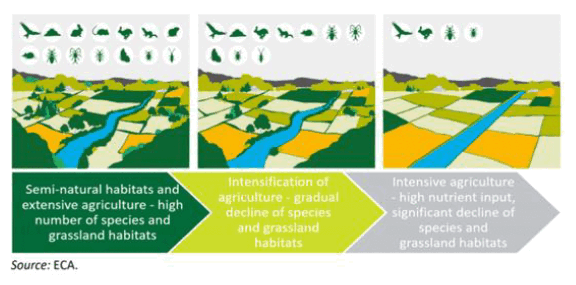
A change of land use can result in various impacts on biodiversity: for example, conversion from semi-natural grazing to forestry may be detrimental, as the diversity and richness of wildlife associated with the former can be considerable, whereas conversion from improved grassland (which can be poor for wildlife) to forestry is likely to make little difference[16].
Farmland is particularly able to deliver services such as energy sources, food production and recreation. However, the Natural Capital Asset Index shows that the natural capital[17] asset value of agricultural and cultivated land has been reducing over recent years. The Index is made up of quality (38) x quantity indicators (ie area) and the recent agriculture decline seems to be driven by a reduction in land designated arable land and market gardens[18].
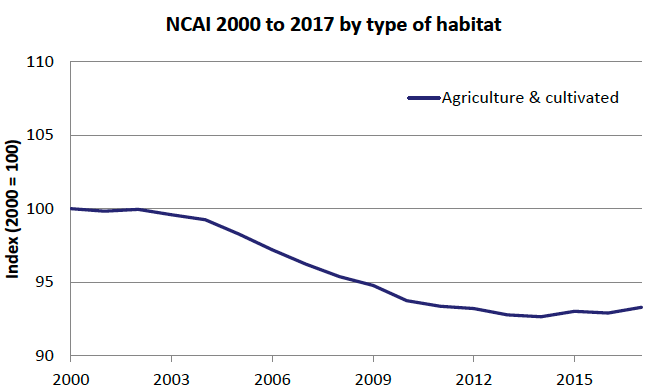
Source: Natural Capital Asset Index
Biodiversity varies across regions, land uses and species. A commonly used indicator for biodiversity is bird populations. Research by Nature.Scot shows that most wader species have seen significant declines while seed-eaters show stable or increasing long-term trends.
| Species | Long-term trend | Short-term trend |
|---|---|---|
| Common snipe | Increase | Increase |
| Curlew | Decrease | Decrease |
| Lapwing | Decrease | Decrease |
| Oystercatcher | Decrease | Decrease (slowing) |
| Redshank | Decrease | Decrease (slowing) |
| Linnet | Increase | Stable |
| Skylark | Stable | Decrease (accelerating) |
| Tree sparrow | Increase | Increase |
| Yellowhammer | Stable | Increase |
| Corn bunting | Decrease | Increase |
Long-term changes in Scottish and UK farmland bird populations have been driven by many factors including agricultural intensification, reduced diversity of crop types within farms and reductions in spring-sown crops[19]. Agri-environment schemes have been in place in Scotland for around two decades, helping reverse impacts with results varying between different species.
Pollinators play an essential role in plant reproduction and ecosystem functions, and there are currently large worrying declines in their populations. The NatureScot, some bird species such as curlew (number precariously low in many parts), oystercatcher, and redshank can benefit from it, with the right management in place. On the other hand, intensively grazed fields have relatively little habitat value for many farmland birds, and local extinctions are more common in grass-dominated areas compared to arable areas[22].
NatureScot has a project[23] testing an outcome based approach to supporting biodiversity on farms and crofts in Scotland and is beginning a new pilot with dairy farms in South West Scotland, based on the example of the BRIDE project[24] in Southern Ireland.
Contact
There is a problem
Thanks for your feedback